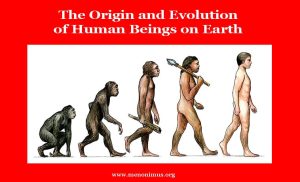The Origin and Evolution of Human Beings on Earth
The Origin and Evolution of Human Beings on Earth
The Origin and Evolution of Human Beings on Earth
A human being is a member of the species Homo sapiens, characterized by bipedalism (walking on two legs), opposable thumbs, a large brain relative to body size, and the ability to communicate using complex language. Humans are also known for their capacity for abstract thought, creativity, and culture, which includes art, music, literature, and religion. Additionally, humans are social animals and typically form complex societies that can range from small groups to large nations. As individuals, humans are also shaped by their unique life experiences, personal beliefs, and cultural background, which can influence their behavior, values, and worldview.
The origin and evolution of human beings on Earth is a fascinating topic that has been explored by scientists, anthropologists, and historians for many years. The story of human evolution begins over six million years ago with the emergence of our earliest primate ancestors. Over time, these early primates evolved into the hominids, a group of bipedal primates that includes modern humans and their extinct relatives.
The story of human evolution is a complex one, with many different branches and species that have emerged and disappeared over time. Scientists have pieced together this story using a combination of fossil evidence, genetic analysis, and archaeological research. In this essay, we will explore the major events in human evolution and how they have led to the emergence of modern humans.
Early Primates
The story of human evolution begins with the emergence of the first primates, which lived about 65 million years ago. These early primates were small, tree-dwelling mammals that were adapted to life in the trees. They had grasping hands and feet that allowed them to cling to branches and move around in the trees.
Over time, these early primates evolved into a variety of different forms, including the prosimians and the simians. The prosimians are the most primitive of the primates and include the lemurs and tarsiers. The simians are more advanced and include monkeys and apes.
The Hominids
Hominids are a group of bipedal primates that include modern humans and their extinct relatives. The earliest hominids emerged about six million years ago and were adapted to life in the forests of Africa. These early hominids had a combination of ape-like and human-like features, including a small brain, a protruding face, and long arms.
Over time, the hominids evolved into a variety of different forms, each adapted to their specific environment. Some hominids, such as Australopithecus afarensis, were adapted to life in the savannahs of East Africa. Others, such as Paranthropus boisei, were adapted to life in the forests of East Africa.
The first members of the genus Homo, which includes modern humans, emerged about 2.5 million years ago. These early humans had a number of key adaptations that set them apart from their hominid ancestors. They had larger brains, smaller teeth, and were able to make and use tools. The earliest members of the genus Homo were Homo habilis, which lived about 2.5 million years ago.
Over time, the genus Homo evolved into a variety of different forms, including Homo erectus, Homo heidelbergensis, and Homo neanderthalensis. Each of these species had a unique set of adaptations that allowed them to survive and thrive in their specific environments.
Modern Humans
The emergence of modern humans, Homo sapiens, is a relatively recent event in human evolution. The earliest fossils of modern humans date back about 300,000 years, and modern humans are thought to have emerged in Africa about 200,000 years ago.
One of the key adaptations that set modern humans apart from their hominid ancestors was their ability to communicate using language. Modern humans also had larger brains than their ancestors, which allowed them to think and reason in more complex ways.
Modern humans spread out of Africa and into other parts of the world about 60,000 years ago. They encountered a variety of different environments, from the cold of Europe to the dry deserts of Australia. To survive in these environments, modern humans had to adapt and develop new technologies.
Conclusion
The story of human evolution is a complex one that has been pieced together over many years of research. 0 0 0.
The Origin and Evolution of Human Beings on Earth: Facts
Here are key facts about the origin and evolution of human beings on Earth:
Early Evolutionary Beginnings
- Origin of Life (around 3.5-4 billion years ago): Life on Earth began with simple single-celled organisms, such as bacteria. These early life forms evolved in the planet’s oceans.
- Evolution of Multicellular Life (around 600 million years ago): Multicellular organisms, such as plants and animals, began to develop. This period marked the diversification of life forms during the Cambrian Explosion.
Emergence of Primates
- First Primates (around 55-65 million years ago): The earliest primates evolved shortly after the extinction of the dinosaurs. These small, tree-dwelling mammals had characteristics like grasping hands and binocular vision.
- Evolution of Great Apes (around 15-20 million years ago): The lineage leading to modern apes and humans began to diverge from other primates, giving rise to the great apes, such as gorillas, chimpanzees, and humans.
Hominid Evolution
- Australopithecus (around 4-2 million years ago): Australopithecus species, such as Australopithecus afarensis, are among the earliest known hominids (human ancestors). They walked upright and lived primarily in Africa.
- Development of Bipedalism: One of the defining traits of early hominids was bipedalism—walking on two legs. This adaptation is believed to have been beneficial for traveling long distances and seeing over tall grass.
Emergence of the Genus ‘Homo’
Homo habilis (around 2.4-1.4 million years ago): Often considered the first member of the genus ‘Homo’, *Homo habilis* had a larger brain and used simple stone tools, marking the beginning of significant technological development.
Homo erectus (around 1.9 million to 110,000 years ago): *Homo erectus* was the first human ancestor to spread out of Africa into Europe and Asia. They had a larger brain than earlier hominids, developed more sophisticated tools, and may have used fire.
Evolution of Modern Humans
- Homo sapiens (around 300,000 years ago to present): Modern humans, ‘Homo sapiens’, evolved in Africa and later spread throughout the world. Early humans were hunter-gatherers, using complex tools, developing language, and creating art.
- Neanderthals and Denisovans (around 400,000-40,000 years ago): These closely related species coexisted with early modern humans. Neanderthals lived in Europe and western Asia, while Denisovans inhabited parts of Asia. Evidence suggests some interbreeding occurred between these groups and ‘Homo sapiens’.
The Spread of Homo sapiens
- Out of Africa Theory (around 60,000-70,000 years ago): ‘Homo sapiens’ began migrating out of Africa and spreading across Asia, Europe, Australia, and eventually the Americas. This migration led to the global distribution of humans.
- Development of Agriculture (around 10,000-12,000 years ago): The Neolithic Revolution marked a significant shift from hunting and gathering to agriculture and settlement. This change led to the development of complex societies, cities, and eventually civilizations.
Technological and Cultural Evolution
- Stone Age Tools: Early humans developed stone tools, such as hand axes and spear points, which were critical for hunting and daily survival.
- Development of Language and Art: The development of language allowed for better communication and social organization. Early humans also created art, as evidenced by cave paintings, carvings, and jewelry.
- Advancements in Technology: Over time, human beings advanced from using stone tools to creating metal tools and weapons, developing pottery, weaving, and building structures.
Genetic Evolution and Diversity
- Genetic Adaptations: Over time, humans developed various genetic adaptations to their environments, such as changes in skin color, lactose tolerance, and resistance to certain diseases.
- Human Diversity: Modern humans are highly diverse, both genetically and culturally. This diversity results from a combination of evolutionary adaptations, migrations, and cultural developments.
Conclusion
The origin and evolution of human beings on Earth is a complex story spanning millions of years, from early primate ancestors to the technologically advanced societies of today. Human evolution has been marked by significant biological, cultural, and technological changes, leading to the diverse species we are today.
n Beings on Earth
Sources:
- “Sapiens: A Brief History of Humankind” by Yuval Noah Harari
- “The Origin of Species” by Charles Darwin
- Smithsonian National Museum of Natural History
- “The Rise of Humans: Great Scientific Debates” from The Great Courses
- “The Story of Us” from PBS
- “Becoming Human” from NOVA
- National Geographic.
The Origin and Evolution of Human Beings on Earth
You May Like:
- The Steady State Theory of the Origin of the Universe
- The History of Jupiter Exploration
- The Exploration of the Sun
N.B. The article ‘The Origin and Evolution of Human Beings on Earth’ originally belongs to the book ‘Essays on Science And Technology‘ by Menonim Menonimus.
N.B. If you find the article ‘The Origin and Evolution of Human Beings on Earth’ to be helpful, please share your thoughts and feelings.
The Origin and Evolution of Human Beings on Earth
Books of Composition by M. Menonimus:
- Advertisement Writing
- Amplification Writing
- Note Making
- Paragraph Writing
- Notice Writing
- Passage Comprehension
- The Art of Poster Writing
- The Art of Letter Writing
- Report Writing
- Story Writing
- Substance Writing
- School Essays Part-I
- School Essays Part-II
- School English Grammar Part-I
- School English Grammar Part-II..
Related Search:
- Introduction to Human Evolution
- Evolution of Modern Humans
- History of Automobile
- The Invention of the Car
- History of Mobile Phones
- Evolution of Mobile Phone











